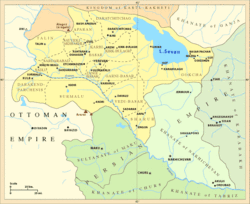خانات نخجوان
خانات نخجوان یکی از خاناتی [۵] بودند که در دوره افشاریه در سال ۱۷۴۷ در نخجوان بنیان گذاشته شدند.قلمرو این خانات جایی است که امروزه جمهوری خودمختار نخجوان و استان وایوتسجور ارمنستان هستند.این خانات به خاطر شهر پایتخت این خانات یعنی نخجوان به این نام شهرت گرفت.[۶]
خانات نخجوان خانات نخجوان نخجوان | |||||||||
|---|---|---|---|---|---|---|---|---|---|
| ۱۷۴۷–۱۸۲۸ | |||||||||
 خانات ایروان و نخجوان در سال ۱۸۰۰ میلادی. | |||||||||
| وضعیت | خانات زیر تابعیت ایران[۱] | ||||||||
| پایتخت | نخجوان | ||||||||
| زبان(های) رایج | فارسی (رسمی),[۲][۳][۴] | ||||||||
| تاریخ | |||||||||
• بنیانگذاری | ۱۷۴۷ | ||||||||
• فروپاشی | ۱۸۲۸ | ||||||||
| |||||||||
تاریخ
ویرایشتا دوران فروپاشی دودمان صفوی ، نخجوان به عنوان بخشی از قلمروی حکومتی ولایت ایروان شناخته میشد.[۷]
منابع
ویرایش- ↑ Bournoutian, George A. (2016). The 1820 Russian Survey of the Khanate of Shirvan: A Primary Source on the Demography and Economy of an Iranian Province prior to its Annexation by Russia. Gibb Memorial Trust. p. xvii. ISBN 978-1909724808.
Serious historians and geographers agree that after the fall of the Safavids, and especially from the mid-eighteenth century, the territory of the South Caucasus was composed of the khanates of Ganja, Kuba, Shirvan, Baku, Talesh, Sheki, Karabagh, Nakhichivan and Yerevan, all of which were under Iranian suzerainty.
- ↑ Swietochowski, Tadeusz (2004). Russian Azerbaijan, 1905-1920: The Shaping of a National Identity in a Muslim Community. Cambridge: Cambridge University Press. p. 12. ISBN 978-0521522458.
(...) and Persian continued to be the official language of the judiciary and the local administration [even after the abolishment of the khanates].
- ↑ Pavlovich, Petrushevsky Ilya (1949). Essays on the history of feudal relations in Armenia and Azerbaijan in XVI - the beginning of XIX centuries. LSU them. Zhdanov. p. 7.
(...) The language of official acts not only in Iran proper and its fully dependant Khanates, but also in those Caucasian khanates that were semi-independent until the time of their accession to the Russian Empire, and even for some time after, was New Persian (Farsi). It played the role of the literary language of class feudal lords as well.
{{cite book}}:|access-date=requires|url=(help) - ↑ Homa Katouzian, "Iranian history and politics", Published by Routledge, 2003. pg 128: "Indeed, since the formation of the Ghaznavids state in the tenth century until the fall of Qajars at the beginning of the twentieth century, most parts of the Iranian cultural regions were ruled by Turkic-speaking dynasties most of the time. At the same time, the official language was Persian, the court literature was in Persian, and most of the chancellors, ministers, and mandarins were Persian speakers of the highest learning and ability."
- ↑ William Bayne Fisher, Peter Avery, Ilya Gershevitch, Gavin Hambly, Charles Melville. The Cambridge History of Iran: From Nadir Shah to the Islamic Republic. Cambridge University Press, 1991. شابک ۰۵۲۱۲۰۰۹۵۴, 9780521200950
- ↑ Hewsen, Robert H. Armenia: a Historical Atlas. Chicago, IL: University of Chicago Press, 2001, map 149.
- ↑ Floor 2008, p. 171.